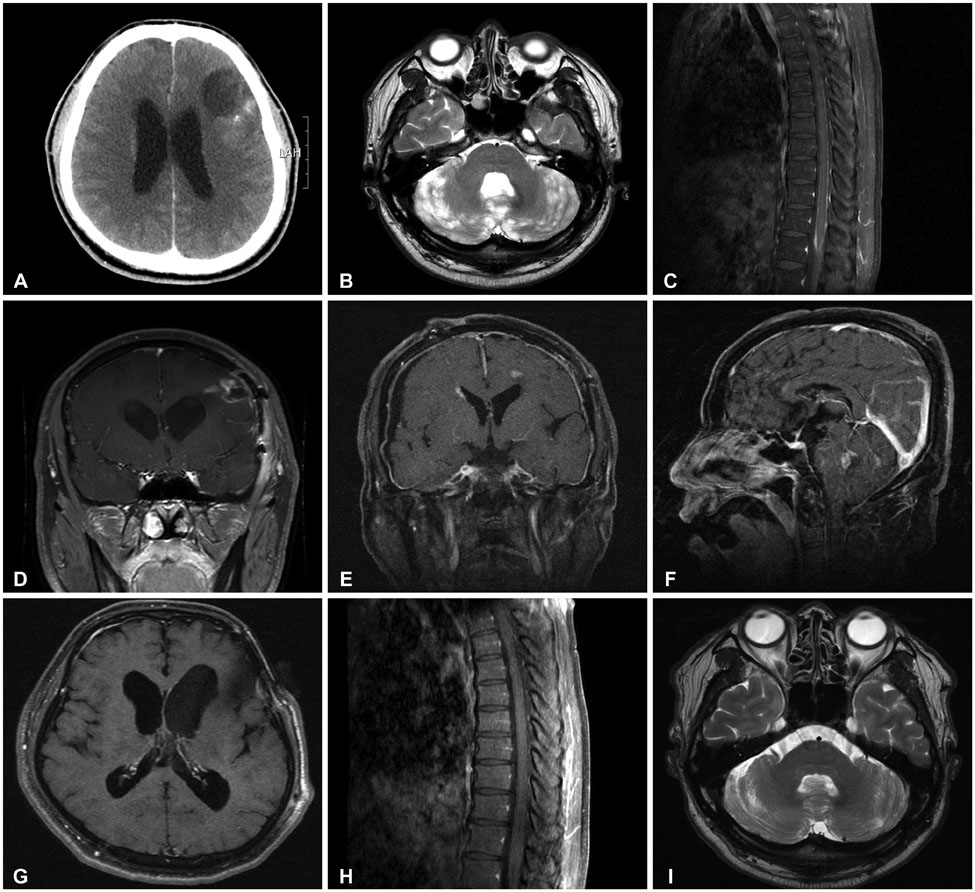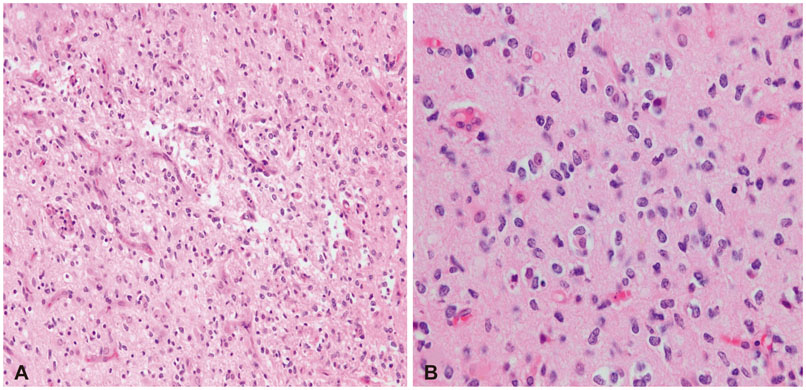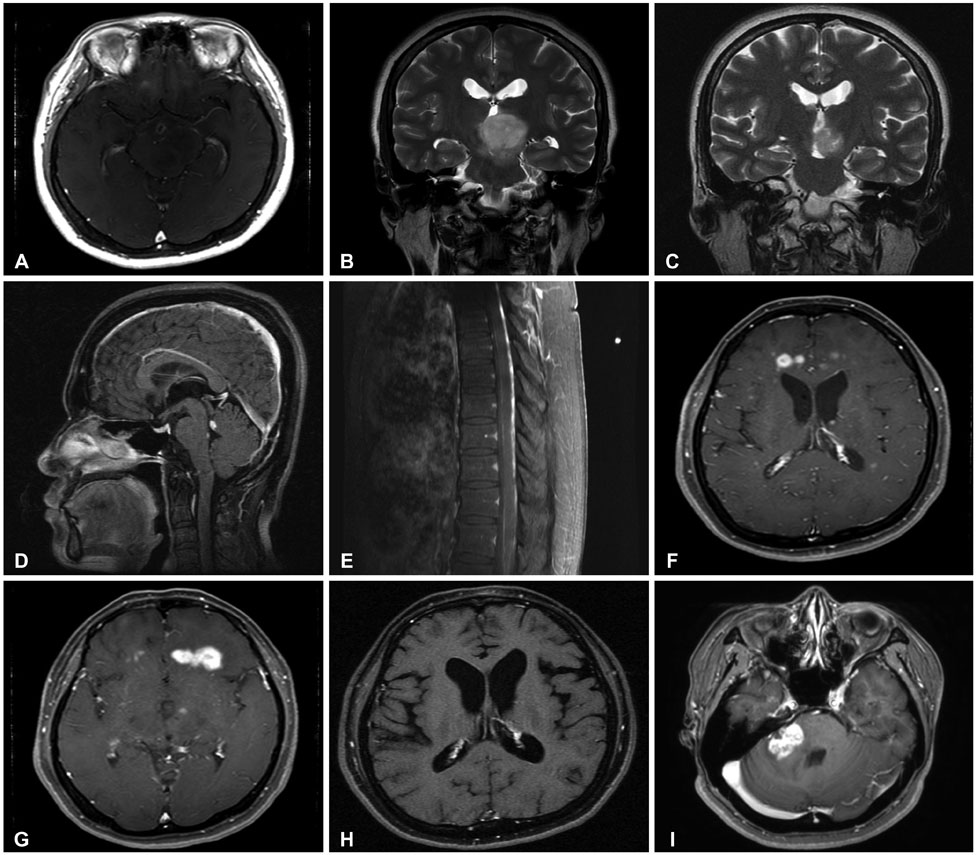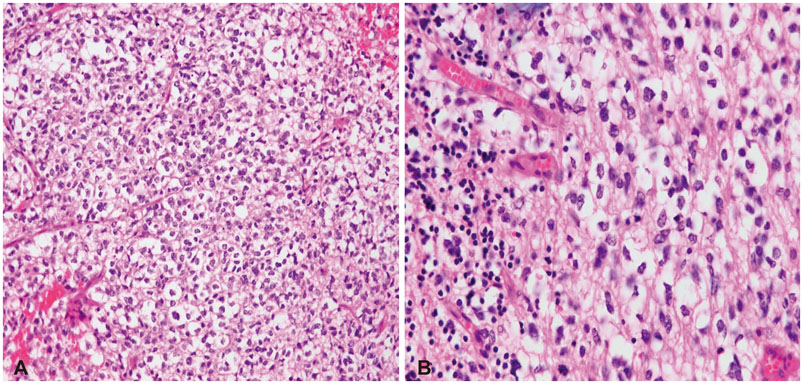Brain Tumor Res Treat.
2017 Oct;5(2):99-104. 10.14791/btrt.2017.5.2.99.
Response of Leptomeningeal Dissemination of Anaplastic Glioma to Temozolomide: Experience of Two Cases
- Affiliations
-
- 1Department of Neurosurgery, Seoul National University College of Medicine, Seoul, Korea.
- 2Department of Pathology, National Cancer Center, Graduate School of Cancer Science and Policy, Goyang, Korea.
- 3Department of Cancer Biomedical Science, National Cancer Center, Graduate School of Cancer Science and Policy, Goyang, Korea. nsghs@ncc.re.kr
- KMID: 2396454
- DOI: http://doi.org/10.14791/btrt.2017.5.2.99
Abstract
- The incidence of leptomeningeal dissemination (LMD) of anaplastic glioma has been increasing. LMD can be observed at the time of initial presentation or the time of recurrence. As a result of both rarity and unusual presentation, a standard therapy has not yet been suggested. In contrast to leptomeningeal carcinomatosis for systemic solid cancers, a relatively prolonged survival is observed in some patients with LMD of anaplastic gliomas. Treatment modalities include whole craniospinal irradiation, intra-cerebrospinal fluid (CSF) chemotherapy, and systemic chemotherapy. In some cases, response to temozolomide (TMZ), with or without combined radiation has been reported. Here, we report two cases of LMD of an anaplastic glioma. In one case LMD presented at the time of diagnosis, and in the other at the time of recurrence after radiation. CSF cytology was positive in both cases, and persisted in spite of intrathecal methotrexate chemotherapy. Later, TMZ was prescribed for progressing brain parenchymal lesions, and both radiological and cytological responses were obtained after oral TMZ treatment.
Keyword
MeSH Terms
Figure
Cited by 1 articles
-
Leptomeningeal Metastasis in Gliomas : Clinical Characteristics and Risk Factors
Jeyul Yang, Ji-Woong Kwon, Sang Hoon Shin, Heon Yoo, Kyu-Chang Wang, Sang Heyon Lee, Ho-Shin Gwak
J Korean Neurosurg Soc. 2023;66(4):465-475. doi: 10.3340/jkns.2022.0166.
Reference
-
1. Hansen N, Wittig A, Hense J, Kastrup O, Gizewski ER, Van de. Long survival of primary diffuse leptomeningeal gliomatosis following radiotherapy and temozolomide: case report and literature review. Eur J Med Res. 2011; 16:415–419.
Article2. Saito R, Kumabe T, Jokura H, Shirane R, Yoshimoto T. Symptomatic spinal dissemination of malignant astrocytoma. J Neurooncol. 2003; 61:227–235.3. Michotte A, Chaskis C, Sadones J, Veld PI, Neyns B. Primary leptomeningeal anaplastic oligodendroglioma with a 1p36-19q13 deletion: report of a unique case successfully treated with Temozolomide. J Neurol Sci. 2009; 287:267–270.
Article4. Ostermann S, Csajka C, Buclin T, et al. Plasma and cerebrospinal fluid population pharmacokinetics of temozolomide in malignant glioma patients. Clin Cancer Res. 2004; 10:3728–3736.
Article5. Louis DN, Perry A, Reifenberger G, et al. The 2016 World Health Organization Classification of Tumors of the Central Nervous System: a summary. Acta Neuropathol. 2016; 131:803–820.
Article6. Sanson M, Ameri A, Monjour A, et al. Treatment of recurrent malignant supratentorial gliomas with ifosfamide, carboplatin and etoposide: a phase II study. Eur J Cancer. 1996; 32A:2229–2235.
Article7. Gwak HS, Joo J, Shin SH, et al. Ventriculolumbar perfusion chemotherapy with methotrexate for treating leptomeningeal carcinomatosis: a Phase II Study. Oncologist. 2014; 19:1044–1045.
Article8. Onda K, Tanaka R, Takahashi H, Takeda N, Ikuta F. Cerebral glioblastoma with cerebrospinal fluid dissemination: a clinicopathological study of 14 cases examined by complete autopsy. Neurosurgery. 1989; 25:533–540.
Article9. Yung WA, Horten BC, Shapiro WR. Meningeal gliomatosis: a review of 12 cases. Ann Neurol. 1980; 8:605–608.
Article10. Dardis C, Milton K, Ashby L, Shapiro W. Leptomeningeal metastases in high-grade adult glioma: development, diagnosis, management, and outcomes in a series of 34 patients. Front Neurol. 2014; 5:220.
Article11. Roldán G, Chan J, Eliasziw M, Cairncross JG, Forsyth PA. Leptomeningeal disease in oligodendroglial tumors: a population-based study. J Neurooncol. 2011; 104:811–815.
Article12. Bae JS, Yang SH, Yoon WS, Kang SG, Hong YK, Jeun SS. The clinical features of spinal leptomeningeal dissemination from malignant gliomas. J Korean Neurosurg Soc. 2011; 49:334–338.
Article13. Franceschi E, Cavallo G, Scopece L, et al. Temozolomide-induced partial response in a patient with primary diffuse leptomeningeal gliomatosis. J Neurooncol. 2005; 73:261–264.
Article14. Jicha GA, Glantz J, Clarke MJ, et al. Primary diffuse leptomeningeal gliomatosis. Eur Neurol. 2009; 62:16–22.
Article
- Full Text Links
- Actions
-
Cited
- CITED
-
- Close
- Share
- Similar articles
-
- The Clinical Features of Spinal Leptomeningeal Dissemination from Malignant Gliomas
- Solitary Primary Leptomeningeal Glioma: Case Report
- Temozolomide Chemotherapy for the Treatment of a Recurrent and Progressive Malignant Glioma
- Overcoming Treatment Resistance in High Grade Gliomas
- Leptomeningeal Dissemination of a Low-Grade Brainstem Glioma without Local Recurrence





